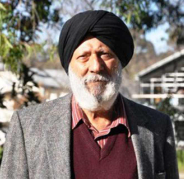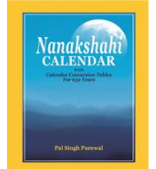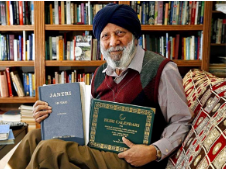A renowned Sikh scholar and internationally recognized expert on Calendrical Science, S. Pal Singh Purewal's outstanding contribution to Sikh history has been the Nanakshahi calendar. In the old Bikrami calendar, some gurpurabs (Sikhs' sacred days for commemorating certain events) came twice a year, and some gurpurabs did not come even once a year. Taking cognizance of these anomalies, Pal Singh Purewal took the initiative to remedy the situation. For nearly fifteen years, he toiled hard to sort out the problem. His endeavor led to the creation of the Nanakshahi calendar. Announcing its release, he opined: "All communities and faiths have their own calendar as a mark of their distinct cultural identity. So, just as the Islamic world has the Hijri calendar and Hindus have the Bikrami calendar, the Sikhs will have a Nanakshahi calendar along with the common era (CE) calendar, which is in use throughout the world."
Pal Singh Purewal was born in 1932 at Village Shankar, District Jalandhar, Punjab, India. His father was a village land record officer, and his mother was a housemaker. After receiving B. Sc. and B.T. degrees, he started his professional life as a teacher. After serving as a school teacher for about a decade, he emigrated to the United Kingdom in 1965. Due to his technical acumen and willingness to adjust to altogether different working conditions, in the beginning, he picked entry-level technical jobs. He later worked with Texas Instruments as Senior Engineer. To explore career advancement opportunities and for an extended family reunion, he emigrated to Canada in 1974. Herein, with his hard work and continuous learning attitude, he rose to the level of Manager (Technical) and member of the Board of Directors of the reputed Miller Office Group.
His interest in calendars dated back to the late 1950s. Until 2003, before the Sikhs adopted the Nanakshahi calendar as their official calendar, they, along with Hindus, followed the ancient Bikrami calendar. The Bikrami calendar contains a complex set of rules to determine the dates for annual festivals and days of observance. According to some people, it is an unwieldy merger of lunar and solar cycles. That led to much variability in dates for yearly events, which is problematic in general. So, Pal Singh Purewal took the cudgels to solve the problem. When he first considered creating a calendar, especially for Sikhs, he did so with three core principles. (i) First and foremost, it must respect sacred holy scriptures (ii) Secondly, it should get rid of the lunar calendar and use only a solar one. (iii) Thirdly, all the dates must be fixed and not vary yearly.
In the 1950s, Purewal studied more than 120 astronomy texts, including many world calendars, e.g., the Gregorian calendar. He also examined over 1,000 years old almanacs to understand the Hindu calendar's development process. His keen interest in science and mathematics behind the astronomical observations encouraged him to embark on such an arduous journey. In addition, he wanted to unravel the reason behind the different dates reported by various authors for the same historical event. He also desired to remove the discrepancy between the currently prevalent dates of specific historical events from their original dates. His efforts were fructified in the form of his own jantri (calendar). He created a book that spanned 500 years. It contained actual dates for numerous historical events. The calendar stretched back to the first year of the founding of the Sikh faith in 1469. He consolidated data from 34 sources from earlier authors and used that information to identify historical dates that could be checked for accuracy.
Since the 1960s, he had published several research papers on various aspects of the Sikh calendar and 'Jantri 500 YEARS - An Almanac' and 'Hijri Calendar.' His almanac was published in 1994 by the Punjab School Education Board, Mohali, a renowned educational institution in Punjab, India. This almanac provided comparative dates daily from 1469 to 2000 [CE] in the lunar and solar Bikrami calendars, the Common Era calendar, and the Hijri calendar. It also provided a scholarly treatise on various calendars.
Purewal designed the Nanakshahi Calendar. The calendar conformed to the length of the tropical year and fixed the dates for gurpurabs and Sikh festivals. Shiromani Gurdwara Parbhandhak Committee (SGPC), Sikh's largest representative body, adopted the Nanakshahi calendar in 2003 as its official calendar. The unique features of the Nanakshahi Calendar included: (i) The calendar was named after Guru Nanak, with its First year starting from 1469 CE - the birth year of the Guru. (ii) The year 533rd Nanakshahi year (then the current year) began on 1 Chet Nanakshahi, March 14, 2001. (iii) Based on the length of the tropical year 365d 5h 48m 45s, the number of days in each month of a year were fixed to either 31 or 30. The first five months contained 31 days each and the last seven 30 days each, a straightforward rule to remember. (iii) It had a fixed leap year rule, i.e., last month to have one extra day every four years. (iv) It presented fixed dates of Sangrands in the Common Era. (v) It portrayed permanent relation between seasons and months and was predicted to stay in coherence with the depiction of seasons in Gurbani. (vi) Gurpurabs days were fixed, and all Gurpurabs occurred only once every year. (vii) No 'impure' (or Malamasa) month existed in any year in the Nanakshahi calendar compared to the Hindu lunar calendar.
The SGPC adopted and implemented the calendar in 2003, which was termed as a symbol of the distinct identity of Sikhism, replacing the former times Bikrami calendar. Nanakshahi Calendar remained in force for almost seven years. Based on its dates, all gurpurabs were celebrated worldwide. Because of the implementation of the original Nanakshahi calendar, Purewal gained worldwide fame. But the calendar had been courting controversies on specific issues, including the dates of religious festivals and gurpurabs. The SGPC rolled it back under pressure from Sant Samaj, which was in alliance with the Shiromani Akali Dal (SAD) during the SGPC polls in 2010. SGPC replaced the original version of the calendar with a new one, which was amended considering the old Bikrami calendar, but its nomenclature 'Nanaksahi calendar' was retained. Currently, unlike SGPC, many other gurdwara committees, including Pakistan Sikh Gurdwara Parbandhak Committee (SGPC), follow the original version of the Nanakshahi Calendar.
Pal Singh Purewal also created an Islamic calendar for Pakistan, for which both Shia and Sunni sects of Islam agreed. Indo-Pakistan relations got a boost in 2007 when the Government of Pakistan released a Hijri Calendar (Islamic calendar) prepared by Pal Singh Purewal. The Hijri Calendar (1 AH to 1500 AH) helps to know the exact date and time of various Muslim festivals. For his remarkable book: Hijri Calendar, Pal Singh Purewal was bestowed with the "lifetime achievement" award. As a token of respect for his outstanding contribution to Islam, Dyal Singh College, Pakistan dedicated its library to his name.
For his work on the Nanakshahi calendar, Pal Singh Purewal was awarded an honorary doctorate by the World Sikh University, UK. In addition, he was awarded the Queen's Golden Jubilee medal for his three-decade long voluntary work. He was also recognized in the Alberta Legislature by the Minister of Community Development, Hon'ble Gene Zwozdesky.
I had the good fortune to meet him in 2005, when, on my invitation, he delivered an invited lecture on Nanakshahi Calendar at Gurudwara Ghat Sahib, Nangal. Therein, he very patiently answered the audience's queries about the calendar to everyone's satisfaction. I visited him in July 2006 in Edmonton, Canada and was much impressed by his humble nature, superb knowledge of astronomical observations and excellent mathematical analysis.
On September 22, 2022, Pal Singh Purewal breathed his last at the age of 90 in Edmonton, Canada. A devout and compassionate Sikh, S. Pal Singh Purewal shall be remembered for his seminal work in calendrical science, which has put the Nanakshahi Calendar on scientific and authentic footings. Through his monumental work, he has provided an incomparable tool in the hands of researchers/academicians to test and verify the authenticity of historical documents. All this is a part of his great legacy.








